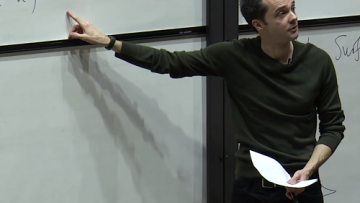Oxford Mathematician Thomas Prince talks about his work on the construction of Fano manifolds in dimension four and their connection with Calabi-Yau geometry.
Dynamically consistent parameterization of mesoscale eddies
Abstract
This work aims at developing new approach for parameterizing mesoscale eddy effects for use in non-eddy-resolving ocean circulation models. These effects are often modelled as some diffusion process or a stochastic forcing, and the proposed approach is implicitly related to the latter category. The idea is to approximate transient eddy flux divergence in a simple way, to find its actual dynamical footprints by solving a simplified but dynamically relevant problem, and to relate the ensemble of footprints to the large-scale flow properties.
The strange instability of the equatorial Kelvin wave
Abstract
The Kelvin wave is perhaps the most important of the equatorially trapped waves in the terrestrial atmosphere and ocean, and plays a role in various phenomena such as tropical convection and El Nino. Theoretically, it can be understood from the linear dynamics of a stratified fluid on an equatorial beta plane, which, with simple assumptions about the disturbance structure, leads to wavelike solutions propagating along the equator, with exponential decay in latitude. However, when the simplest possible background flow is added (with uniform latitudinal shear), the Kelvin wave (but not the other equatorial waves) becomes unstable. This happens in an extremely unusual way: there is instability for arbitrarily small nondimensional shear p, and the growth rate is proportional to exp(-1/p^2) as p->0. This in contrast to most hydrodynamic instabilities, in which the growth rate typically scales as a positive power of p-p_c as the control parameter p passes through a critical value p_c.
This Kelvin wave instability has been established numerically by Natarov and Boyd, who also speculated as to the underlying mathematical cause. Here we show how the growth rate and full spatial structure of the instability may be derived using matched asymptotic expansions applied to the (linear) equations of motion. This involves an adventure with Whittaker functions in the exponentially-decaying tails of the Kelvin waves, and a trick to reveal the exponentially small growth rate from a formulation that only uses regular perturbation expansions. Numerical verification of the analysis is also interesting and challenging, since special high-precision solutions of the governing ODE are required even when the nondimensional shear is not that small (circa 0.5).
Jacob Bernoulli’s role in the history of elasticity: From a discussion with a craftsman to the discovery of the elasticity rules
Abstract
Jacob Bernoulli is known for his studies of the curves, infinitesimal math- ematics and statistics. However, before being a professor in mathematics, he taught experimental physics at the University of Basel. This explains his high interest in solving physical problems with newly developed Leibnizian calculus. In his scientific notebook, Meditationes, there are more than thirty notes about various mechanical problems for solving of which Bernoulli has applied Leibnizian calculus and has advanced this method along the way. A discussion with a craftsman brought Bernoulli’s attention to the problem of the strength of a beam early in his career and occupied his mind until his death. The craftsman’s narration based on his experience highlighted the flaws in Galilean-Leibnizian theory of the strength of a beam. This was the starting point of Bernoulli’s quest to mathematically find the profile of a bent beam (the Elastica Problem) and the physical laws governing it. He started a challenge to encourage other mathematicians of the time to study the problem, providing a hint hidden in an anagram. Although he published his solution of the Elastica Problem in 1694, that was not the end of the quest for him. Studying his unpublished notes in Meditationes reveals that over the last decade of his life, Bernoulli has reconsidered the problem. In my project, I demonstrate that he has found remarkable concepts such as mean tensile stress, and the notion of local stress-strain relation, etc.
One of our aims in Oxford Mathematics is to show what it is like to be an Oxford Mathematics student. With that in mind we have started to make student course materials available and last Autumn we filmed and made available a first year lecture on Complex Numbers. And last week, as we promised, we went a step further and livestreamed a first year lecture. James Sparks was our lecturer and Dynamics his subject.
A generic construction for high order approximation schemes of semigroups using random grids
Abstract
Our aim is to construct high order approximation schemes for general
semigroups of linear operators $P_{t},t \ge 0$. In order to do it, we fix a time
horizon $T$ and the discretization steps $h_{l}=\frac{T}{n^{l}},l\in N$ and we suppose
that we have at hand some short time approximation operators $Q_{l}$ such
that $P_{h_{l}}=Q_{l}+O(h_{l}^{1+\alpha })$ for some $\alpha >0$. Then, we
consider random time grids $\Pi (\omega )=\{t_0(\omega )=0<t_{1}(\omega
)<...<t_{m}(\omega )=T\}$ such that for all $1\le k\le m$, $t_{k}(\omega
)-t_{k-1}(\omega )=h_{l_{k}}$ for some $l_{k}\in N$, and we associate the approximation discrete
semigroup $P_{T}^{\Pi (\omega )}=Q_{l_{n}}...Q_{l_{1}}.$ Our main result is the
following: for any approximation order $\nu $, we can construct random grids $\Pi_{i}(\omega )$ and coefficients
$c_{i}$, with $i=1,...,r$ such that $P_{t}f=\sum_{i=1}^{r}c_{i} E(P_{t}^{\Pi _{i}(\omega )}f(x))+O(n^{-\nu})$
with the expectation concerning the random grids $\Pi _{i}(\omega ).$
Besides, $Card(\Pi _{i}(\omega ))=O(n)$ and the complexity of the algorithm is of order $n$, for any order
of approximation $\nu$. The standard example concerns diffusion
processes, using the Euler approximation for $Q_l$.
In this particular case and under suitable conditions, we are able to gather the terms in order to produce an estimator of $P_tf$ with
finite variance.
However, an important feature of our approach is its universality in the sense that
it works for every general semigroup $P_{t}$ and approximations. Besides, approximation schemes sharing the same $\alpha$ lead to
the same random grids $\Pi_{i}$ and coefficients $c_{i}$. Numerical illustrations are given for ordinary differential equations, piecewise
deterministic Markov processes and diffusions.
Frontiers in Quantitative Finance
On June 13 we will have the Frontiers in Quantitative Finance seminar in London
https://www.maths.ox.ac.uk/groups/mathematical-finance/frontiers-quanti…
Adapted Wasserstein distances and their role in mathematical finance
Abstract
The problem of model uncertainty in financial mathematics has received considerable attention in the last years. In this talk I will follow a non-parametric point of view, and argue that an insightful approach to model uncertainty should not be based on the familiar Wasserstein distances. I will then provide evidence supporting the better suitability of the recent notion of adapted Wasserstein distances (also known as Nested Distances in the literature). Unlike their more familiar counterparts, these transport metrics take the role of information/filtrations explicitly into account. Based on joint work with M. Beiglböck, D. Bartl and M. Eder.



